Syncrude operates the largest oil sands crude oil production facility in the world and produces over 13 percent of Canada's total oil requirements.
|
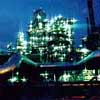 |
To do this, Syncrude mines oil sand from a surface mine, extracts the raw oil, or bitumen, from the sand using steam and hot water, and upgrades it into crude oil by fluid coking, hydroprocessing, hydrotreating and reblending. The final product, called Syncrude Sweet Blend, is sent down a pipeline to three Edmonton area refineries and to pipeline terminals which ship it to refineries in Canada and the United States.
|
|
Oil Sand
Oil sand is composed of sand, bitumen, mineral rich clays and water. The bitumen in the oil sand mined at the Mildred Lake site averages 10.5 percent by weight and is made up of 50 to 60 percent oil, 30 to 35 percent resins and 15 to 25 percent asphaltenes. In its raw state, bitumen is a black, asphalt-like oil — as thick as molasses. It requires upgrading to make it transportable by pipeline and usable by conventional refineries. The upgraded bitumen product consists of naphtha, light and heavy gas oils that are combined to produce a light, sweet crude oil that Syncrude calls Syncrude Sweet Blend.
|
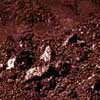
|
Water makes up about four percent of the oil sand by weight. It surrounds each grain of sand, keeping it separate from the oil. Without this water envelope, the oil and the sand could not be separated by the hot water extraction method now being used.
According to the Alberta Energy and Utilities Board, Alberta's oil sand deposits contain 1.7 trillion barrels of bitumen, of which over 300 billion are recoverable by current technology. The total amount is greater than the known reserves of Saudi Arabia.
|
|
| Oil sand is visible on the banks of the Athabasca River, north and south of Fort McMurray, but most of the oil sand in the area lies buried 50 metres or deeper under muskeg and overburden. |
The origin of the oil is a controversial subject among geologists, but the predominant theory is that it evolved in highly organic Cretaceous shales in the southern portion of the Alberta Sedimentary Basin. Underground pressure forced the oil to soak into the existing silt grade sediments and localized sand bodies of the McMurray formation.
|
Mining
Before oil sand can be mined, the layers of muskeg and earth covering it must be removed. Surface vegetation and tree cover is stripped. Suitable soil materials are selectively mined and used in the ongoing reclamation program.
|
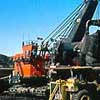 |
Beneath the muskeg is a layer of rocky, clay-like material called overburden. Trucks and shovels pre-strip this material and place it in the mined-out pit. Once removed, the overburden exposes a thick deposit of oil sand.
Much of the oil sand is mined by draglines and piled in windrows along the sides of the mine pit. Bucketwheel reclaimers dig the oil sand from the windrows and place it on the conveyor system where it is transported to the dump pocket and fed to the Extraction plant. |
|
To maintain a steady supply of feed to Extraction, 20 per cent of the oil sand from the base mine comes from Auxiliary Production Systems. These truck and shovel operations deliver oil sand to crushers which size the feed and place it onto the conveyors which deliver it to the dump pocket. |
In 1993, an Extractions Auxiliary Production System, known as hydrotransport or EAPS, was added. This system also uses trucks, shovels and crushers, but the sized feed enters a cyclofeeder where it is mixed with hot water and transported to the Extraction plant via pipeline. This system supports a new generation of mine extraction design and is being used in North Mine and Aurora Mine.
|
Mining Facts
The Base mine has three independent quadrants each with its own dragline, bucketwheel reclaimer and conveyor system. Mobile equipment in the North Mine supplies a significant amount of the total oil sand mined.
Three Walking Draglines
- bucket size: 61 and 68 m3 or 80 and 89 cubic yards
- boom length: 110 m or 360 ft.
- operating radius: 104 m or 340 ft.
- horsepower installed: 28,000 hp each
- operating weight: 6,200 tonnes each
- replacement cost: $75 million each
Three Bucketwheel Reclaimers
|
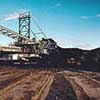 |
- two wheels have 14 buckets at
2.4 m3 or 3.1 cubic yards each; the other bucketwheel is equipped with a "flying wheel" having 24 buckets measuring 1.38 m3 or 1.8 cubic yards each
- total length of machine — 140 m or 560 ft.
- wheel diameter — 13.4 m or 44 ft.
- horsepower installed — 12,000 hp each
- operating weight — 2,400 tonnes each
- replacement cost — $34 million each
|
Conveyor Belts
|
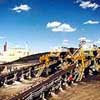 |
- length — about 50 km or 31 miles in the mine and over 1.8 km or 1.2 miles in the extraction plant
- belt size — 1.8 m or 72 inches wide x 40 mm or 1.5 inches thick
- capacity — over 6,300 tonnes of oil sand is moved per hour on each of the four production lines
|
Overburden, Mining and Plant Mobile Equipment
|
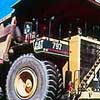 |
- 21 240-ton mechanical drive trucks
- 2,160 horsepower each
- empty weight 317,000 lbs
- loaded weight 830,000 lbs
- 8 320-ton electric drive trucks, 2,160 horsepower each
- 2,682 horsepower each
- empty weight 400,000 lbs
- loaded weight 1,034,000 lbs
- three 30 cubic metre (39 cubic yd.) electric shovels
- one 23 cubic metre (30 cubic yd.) hydraulic shovel
- two 43 cubic metre (56 cubic yd.) hydraulic shovels
- two 45 cubic metre (59 cubic yd.) electric shovels
|
Hydrotransport
|
 |
The North Mine 240-ton and 320-ton haul trucks transport the oil sand to a crushing station and dump into a hopper which feeds the double roll crusher. The oil sand is crushed in a double roll crusher and mixed with water in a cyclofeeder, a massive vessel nearly 35 metres tall. The oil sand is mixed with hot water and fed at high speeds into a pipeline to deliver it to the Extraction Plant.
The Double-Roll Crushers/feeder-breakers have a nominal capacity of 7,500 tonnes per hour.
|
The Syncrude developed hydrotransport system has a nominal capacity of 6,100 tonnes per hour.
One of the keys to the successful implementation of the hydrotransport slurry system is the effective mixing of oil sand and water to form a relatively homogeneous slurry. This mixing occurs in the cyclofeeder. At the bottom of the cyclofeeder are two screen decks. These are used to remove oversize or large chunks. A crusher is attached to the cyclofeeder to handle the rejects which are returned to the hydrotransport process.
Upgrading
|
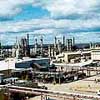 |
During the upgrading process , bitumen is converted from a viscous, tar-like oil to Syncrude Sweet Blend crude oil, a straw-colored liquid which is low in sulphur. Upgrading is divided into two areas: Primary and Secondary.
In Primary Upgrading, heated bitumen from Extraction is processed in the reactors of Syncrude's two Fluid Cokers and an LC-Finer hydroprocessor. A Diluent Recovery Unit (DRU) removes naphtha from the centrifuge product in Extraction.
|
The DRU serves three purposes: it boils off diluent naphtha and returns it to Extraction; recovers light gas oil and sends it directly to a light gas oil hydrotreater; and it produces hot bitumen feed for Cokers and the LC-Finer.
The LC-Finer breaks down bitumen through hydrogen addition over an ebulated catalyst bed to produce a cracked light gas oil. Residuum from the LC-Finer is sent back to the Fluid Cokers where it is mixed with bitumen.
Syncrude's Cokers are capable of handling a heavy bitumen feed. High temperatures in the Coker reactors cause the long bitumen molecules to thermally crack. The lighter products, primarily naphtha and gas oils, become the main ingredients of crude oil.
|
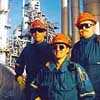 |
Carbon is rejected from the fluid coking process as coke which forms as granules that flow out of the Coker reactor as a fluidized solid stream into another chamber — the burner. The heat for the bitumen cracking process comes from burning some of the coke and returning the hot coke to the reactor. The excess coke is stored in the mined-out pit for potential future use.
The feed from Primary Upgrading to Secondary Upgrading is high in sulphur, nitrogen, metals and unsaturates.
|
|
It is split into raw naphtha, light and heavy gas oil streams. The three streams react with hydrogen in the hydrotreater units at high pressure and temperatures in the presence of a catalyst.
Hydrotreaters remove sulphur and nitrogen and stabilize the oil streams which are blended together to form a light, sweet crude oil. The sulphur is converted to elemental sulphur and blocked or shipped to fertilizer plants to make sulphuric acid. Nitrogen is removed as ammonia and burned in the CO boiler in the Utilities plant.
Fuel gas, produced as a by-product of the refining process, is sent to amine units for hydrogen sulphide removal. The resulting sweet gas is used throughout Upgrading and in the Utilities plant as an energy source.
The product streams of naphtha and gas oils from the hydrotreaters are blended to make a high grade crude oil. This product, known as Syncrude Sweet Blend is sent to Edmonton by pipeline where two-thirds of it is processed. The remainder is distributed to markets in eastern Canada and the mid-Western United States.
Upgrading Facts
|
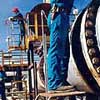 |
The two Fluid Cokers are the largest ever built and were designed to process 72,900 barrels of bitumen a day. As a result of Syncrude's continuous improvement efforts, both routinely process over 110,000 barrels of bitumen per day.
The LC-Finer Hydroprocessor is the third unit of its kind built in the world. It was designed to process 40,000 barrels of bitumen per day, but can now process up to 60,000 barrels of bitumen per day.
The longest run between Fluid Coker maintenance turnarounds is currently 786 days.
The longest run between LC-Finer maintenance turnarounds is 944 days.
|
|
When a Coker and associated units are shut down for maintenance, an extra 1,500 contractors are brought to site.
The Oil Movement and Storage area, where intermediate products are stored, has a capacity of 6.5 million barrels.
Syncrude Sweet Blend, or SSB, is a 31-33o API crude oil with 0.1- 0.2% sulphur. It contains no residue while a typical conventional crude oil might have about 8 percent residue. SSB also has excellent low temperature pour qualities.
|
Extraction
Bitumen is extracted from the oil sand in the Extraction plant. Oil sand comes from the base mine dump pocket by conveyor and enters the tumblers (large, horizontal, rotating drums). The oil sand is slurried by steam, hot water and caustic soda to condition it for bitumen separation. The rotary action also aerates the slurry.
|
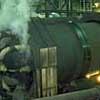 |
The slurry from the tumblers is discharged onto vibrating screens where large materials such as rocks and lumps of clay are rejected. The oil sand slurry is diluted in pump boxes and pumped to the primary separation vessels (PSVs).
The North Mine Hydrotransport System, which started operations in 1997, uses oil sand mined from its truck and shovel operation. This oil sand is sized through a double roll crusher and fed to a cyclofeeder where it is mixed with hot water and fed to a pipeline for delivery to the Extraction Plant.
|
|
As it travels, the oil sand slurry is digested and conditioned in the pipeline. On arrival at Extraction, the oil sand slurry bypasses the tumblers and a distributor directs the slurry to any or all of the existing PSVs to supplement feed from the tumblers.
In the PSVs, bitumen floats to the surface as primary froth. The sand settles out and the middlings and underflow streams are pumped to the Tailings Oil Recovery (TOR) vessels. These deep cone vessels recover most of the remaining bitumen using a technology developed by Syncrude.
|
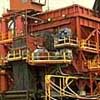 |
Froth from the TOR vessels is recycled to the PSVs to improve its quality. Bitumen recovery is further improved by the secondary floatation plant which processes middlings from the TOR vessels. Froth from the secondary flotation plant is combined with the primary froth stream from the primary separation vessels, deaerated and heated, and fed to the froth treatment plant. |
|
Froth treatment minimizes the water and solids going to the upgrader. Froth is diluted with naphtha and this product of diluted bitumen is either put through inclined plate settlers or through two stages of centrifuges. The combined product from the inclined plate settlers and centrifuges is then put through another set of centrifuges before going to the upgrader.
A Naphtha Recovery Unit (NRU), developed by Syncrude, recovers naphtha from all froth treatment tailings.
The material remaining after the bitumen is extracted from the oil sand is called tailings. The liquid component consists of water, sand, small clay particles and some residual hydrocarbons. The liquids are stored in the 22 square kilometre Mildred Lake Tailings Settling Basin. The sand is stored in the Southwest Sand Storage area. In the settling basin, the solids settle to the bottom and the clarified water is recycled for use in Extraction. In the Southwest Sand Storage area, the sand and clay settle out and the water and clay fines are returned to the settling basin for further clarification.
Extraction Facts
- processes approximately 510,000 tonnes of oil sand per day to produce 92,000 cubic metres, or 580,000 barrels per day of diluted bitumen, with peak production of approximately 560,000 tonnes per day of oil sand and 610,000 barrels per day of diluted bitumen.
- produces 95 million barrels of bitumen per year.
- Extraction's bitumen recovery rate is over 91 percent of the bitumen contained in the oil sand feed
Steam: |
 |
- is supplied by five main boilers (three indoors and two outdoors).
- produced from each boiler is rated at 340,000 kg/hr. of steam or 750,000 lbs./hr. at a pressure of 915 psig and a temperature of 499o C (930o F).
- generated in Upgrading is also managed within the Utilities area.
|
Electricity: |
| |
- is produced by six generators (four steam turbines and two gas turbines) with a total installed capacity of 270 megawatts at 13.8 kv. The normal plant load requirement (including import from the provincial grid) is 200 megawatts.
- is distributed at three voltage levels. Utilities operates high voltage distribution systems (72 kV, 25 kV, 22.9 kV, 13.8 kV, 5 kV) for all plant users.
|
Air: |
| |
- for plant instrumentation and general use is supplied by four high speed centrifugal air compressors.
|
Water: |
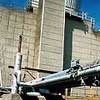 |
- for the boilers and process heaters is produced by eight demineralizer trains averaging about 1,400 m3/hr or 6,000 USgpm.
- for cooling is continuously cycled through three cooling towers having an average cooling capacity of 770 MWH or 2,625,000,000 BTU/hr.
- is recycled through the extraction process at an average rate of
11,400 m3/hr or 50,000 USgpm of recycled water. This water comes from the tailings settling basin and is heated through a series of heat exchangers located in the Upgrading cooling water system and in the diluent recovery and Coker units. The water is split into two streams, tumbler water at 95o C and flood water at 70o C.
|
Nitrogen: |
| |
- is produced in an air fractionation plant, and supplemented by purchased nitrogen for use in the plant.
|
Trivia Bits |
 |
- Site preparation commenced in December 1973
- 43 million field work hours to construct the Syncrude Project
- 10,300 people employed at peak construction
- Syncrude employs approximately 3,500 people and an average of 1,000 contract maintenance and specialist workers.
- Total capital invested in the project from 1973 to 1996 is $5 billion
- In 1996, a ten-year capital investment program, valued today at over $6 billion, started
- 100 millionth barrel produced in July 1982
|
| |
- One billionth barrel produced in April 1998
- Average daily production is 225,000 barrels
- Syncrude shipped 76.7 million barrels of Syncrude Sweet Blend in 1998 and plans to ship over $2 million barrels in 1999
- The Extraction complex is housed in a building about nine storeys high.
- A workforce of over 10,000 swarmed over the site during the peak construction periods in 1976 and 1977; 7,500 of them lived in the construction camps on site. The camp had three kitchens which served up to 27,000 meals a day.
- Over 248,000 cubic metres of concrete, 853 kilometres of piping and 2,920 kilometres of wire and cable were used in the construction of the original plant site.
|
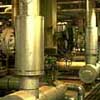 |
- Nearly 450,000 tonnes of materials, equipment, vessels and plant components traveled the highway to the construction site.
- The initial cost of the Syncrude project was $2.3 billion, making it one of the largest single construction projects in Canadian history.
- Around 1500 A.D., Peruvians used bitumen for embalming and waterproofing.
- The Utilities plant produces enough electricity each day to supply a city of 300,000 people.
- The general emission stack is 181 metres high, or 600 feet tall, about the size of a 60- storey building.
- It takes three days at peak pipeline rates for oil to travel from Fort McMurray to Edmonton.
- The Syncrude lease accommodates about 150 species of birds and waterfowl — permanent residents and seasonal migrants — annually.
- Every 24 hours there is enough metal worn off the mining equipment, by abrasive oil sand, to make two full-size pick-up trucks.
- Syncrude is recognized as one of the top 10 engineering achievements in Canada, and one of the 100 best Canadian companies to work for.
|
|